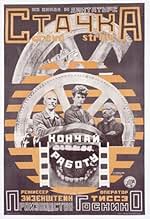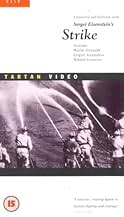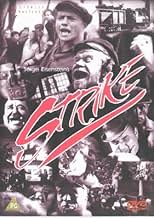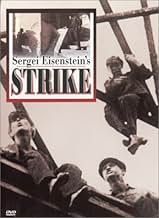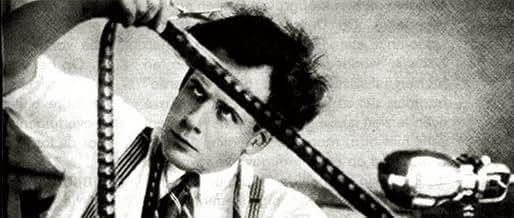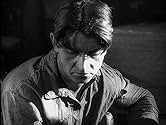AVALIAÇÃO DA IMDb
7,6/10
9,2 mil
SUA AVALIAÇÃO
Na Rússia czarista pré-revolução, operários de uma fábrica fazem greve por melhores condições de trabalho e enfrentam uma dura e violenta repressão.Na Rússia czarista pré-revolução, operários de uma fábrica fazem greve por melhores condições de trabalho e enfrentam uma dura e violenta repressão.Na Rússia czarista pré-revolução, operários de uma fábrica fazem greve por melhores condições de trabalho e enfrentam uma dura e violenta repressão.
- Direção
- Roteiristas
- Artistas
Leonid Alekseev
- Factory Sleuth
- (não creditado)
Daniil Antonovich
- Worker
- (não creditado)
Pyotr Malek
- Police Spy
- (não creditado)
Misha Mamin
- Baby Boy
- (não creditado)
Pavel Poltoratskiy
- Stockholder
- (não creditado)
Avaliações em destaque
More so with the Soviets than with any other film school, we need to resupply the context. The image reigns supreme but not in ways we may understand today, as aesthetic accomplishment or space for contemplation. It is about immediate understanding as formed in the eye so that narrative - the tool by which the Czarist or the bourgeois wrote history, thus a suspicious element - is bypassed, the eye and not the mind is thus tasked to construct. Meant to instruct ideological fervor in a generally unsophisticated audience, these films, propaganda we call them now, stirred into action, not thought. This was in tacit understanding with Marxist principles, that demanded history be foremostly changed than understood.
Change; action; seeing. This is the causal chain the Soviets immersed themselves in, looking for the keys that guide vision.
So, these people eventually grew to know more about the mechanisms that control the image than any other group of people anywhere else in history. They were theoreticians, scientists of film, as well as the actual makers; a now extinct combination, much to our dismay. Eisenstein - and Vertov - were key figures; I mean, here was a man who studied Japanese ideograms to understand synthesized image; who discovered that editing to the beats of the human heart affected more.
So, we are talking about a reflexive cinema, about rhythm as opposed to melody. It's just as well with these films that the narrative content is pretty much discarded by now, even though the agitprop often agitated in the right direction; or have we forgotten that workers, at some point, were truly horribly exploited and that the 8-hour workshift was a bloody struggle? But, being able to quickly sift through caricatures - the fat, capitalist factory owner, the well-groomed, pigheaded stockholders slobbering on their fat cigars - and process the easy distinctions between collective good and the individual selfishness, means we can concentrate on rhythm. On how these thin caricatures that should have been harmless, yet are charged with a power that moves and affects.
It's about the mechanisms that control the image; it is a unique opportunity to have this film, it shows the very image being controlled. The end of the first part, with the shot of huge factory machinery whirring into motion as already the uprising is being set into motion; and later, the hand of the cruel stockholder superimposed over the crowd of strikers, clutching, controlling.
Eisenstein is so adept in his touch that the film is, at times, action, comedy, chamber drama, detective film, policier, paean, sobering catastrophe.
The most amazing sequence; we are with the strikers in an outdoors gathering, as the leader is laying down their demands, yet immediately transported to the lavish mansion of the stockholders as they read them with anger; there is some talk and eventually, satisfied, gleeful, they break out the drinks, an intertitle informs us of their answer to the demands, a polite, civilized refusal 'after careful consideration', while immediately the mounted police is storming the outdoors camp.
It is a stunning display of cinema, how time and space are contorted to accommodate for our passage through and yet the result is a dialectic between images as eminently designed for the eye - not the mind. We see, ergo we know - and are.
Change; action; seeing. This is the causal chain the Soviets immersed themselves in, looking for the keys that guide vision.
So, these people eventually grew to know more about the mechanisms that control the image than any other group of people anywhere else in history. They were theoreticians, scientists of film, as well as the actual makers; a now extinct combination, much to our dismay. Eisenstein - and Vertov - were key figures; I mean, here was a man who studied Japanese ideograms to understand synthesized image; who discovered that editing to the beats of the human heart affected more.
So, we are talking about a reflexive cinema, about rhythm as opposed to melody. It's just as well with these films that the narrative content is pretty much discarded by now, even though the agitprop often agitated in the right direction; or have we forgotten that workers, at some point, were truly horribly exploited and that the 8-hour workshift was a bloody struggle? But, being able to quickly sift through caricatures - the fat, capitalist factory owner, the well-groomed, pigheaded stockholders slobbering on their fat cigars - and process the easy distinctions between collective good and the individual selfishness, means we can concentrate on rhythm. On how these thin caricatures that should have been harmless, yet are charged with a power that moves and affects.
It's about the mechanisms that control the image; it is a unique opportunity to have this film, it shows the very image being controlled. The end of the first part, with the shot of huge factory machinery whirring into motion as already the uprising is being set into motion; and later, the hand of the cruel stockholder superimposed over the crowd of strikers, clutching, controlling.
Eisenstein is so adept in his touch that the film is, at times, action, comedy, chamber drama, detective film, policier, paean, sobering catastrophe.
The most amazing sequence; we are with the strikers in an outdoors gathering, as the leader is laying down their demands, yet immediately transported to the lavish mansion of the stockholders as they read them with anger; there is some talk and eventually, satisfied, gleeful, they break out the drinks, an intertitle informs us of their answer to the demands, a polite, civilized refusal 'after careful consideration', while immediately the mounted police is storming the outdoors camp.
It is a stunning display of cinema, how time and space are contorted to accommodate for our passage through and yet the result is a dialectic between images as eminently designed for the eye - not the mind. We see, ergo we know - and are.
Not Eisensteins most famous film, but it was his first and it's important in the history of cinema. The montage is brilliant and the inventive camerawork alone make it endlessly important. A routine story about workers striking put against the satire of the aristocracy, it seems most of the Russian silent films were like this, but the story isn't whats important in these films, it's the camera use. Eisenstein, Pudovkin, Kuleshov, these filmmakers are possibly the most important group of directors ever.
This is Eisenstein's directorial debut and alongside Citizen Kane it may be one of the most important debuts in the history of film showcasing a fully-fledged artistic maturity. This is a fictitious narrative-driven movie though it is very consonant with reality. As a Communist Eisenstein's aesthetics was opposed to the "bourgeois" art style that considered the artistic object as a subject of contemplation. Eisenstein advocated in theoretical terms in his books and practically with movies such as this a pragmatic vision of art. Movies should have a purpose; they should mobilize the viewer into action by filing him with emotion.
This strategy is obvious early on with the use of the motto from Lenin that links the idea of organized workers and that of social action in an equation of efficiency. The movie tries to prove that the workers are entitled to organization and that only in such a manner they could achieve their full potential. The movie focuses on the workers as a group; there are no "characters" as we have grown accustomed to seeing on screen. The collective character of the workers, though, has a very powerful emotional impact on the viewer because Eisenstein knows how to present it:
1) The workers are presented in the factory, in what would appear to Chaplin, for instance as a medium of alienation. Here, the workers seem "at home" because they are so many they balance the non-human elements expressed by the machines. More than this the brilliant montage sequences emphasize that the workers are in peace in their environment, the visual patters give a clear feeling of the strength of the united workers. Later on with the advent of sound the beauty of an industrial landscape will be extraordinarily depicted by Vertov in Enthusiasm;
2) The workers are contrasted with the fat and greedy capitalists. Their environment is luxurious and far more "human" than a factory. However, Eisenstein makes it appear as a place of sin and debauchery. The cigar smoke emphasizes the strength of the exploiter much like the smoke from the furnace shows the force of the factory. There are many correspondences between the two environments which Eisenstein later uses to achieve some of the greatest and most emotionally engaging associative montages ever displayed. One of the most impressive shows a boss squeezing a lemon to fix himself a drink while the workers are squished by the police forces trying to repress the strike;
3) Individuals predominantly appear only when they are associated with heavy dramatic scenes, the innocent worker who commits suicide ( who only functions as the dramatic instigator of the plot without any real emotion displayed for the actual character who dies even if we know his actual name; it is insinuated that a human life has a meaning only as part of larger community), the child who is killed by the police, the spies who serve as much needed humorous debouches that relieve the tension associated with the workers exploitation but that also build up tension in the sense that they show the stupidity of the bosses and of their methods;
4) The key to the movie is its pragmatics. It is after all a propaganda piece and the ending clearly shows it. The advice addressed to the proletarians not to forget is charged with emotion because it discharges a tension that has been carefully build frame by frame at a rampant pace. Even if we disengage with his doctrine we should keep in mind that Eisenstein's genius can only be acknowledged in its cultural context and related to his conception of art's function in a society. We can screen out the propaganda but we must keep the emotion in order to understand this movie today at its full power.
This strategy is obvious early on with the use of the motto from Lenin that links the idea of organized workers and that of social action in an equation of efficiency. The movie tries to prove that the workers are entitled to organization and that only in such a manner they could achieve their full potential. The movie focuses on the workers as a group; there are no "characters" as we have grown accustomed to seeing on screen. The collective character of the workers, though, has a very powerful emotional impact on the viewer because Eisenstein knows how to present it:
1) The workers are presented in the factory, in what would appear to Chaplin, for instance as a medium of alienation. Here, the workers seem "at home" because they are so many they balance the non-human elements expressed by the machines. More than this the brilliant montage sequences emphasize that the workers are in peace in their environment, the visual patters give a clear feeling of the strength of the united workers. Later on with the advent of sound the beauty of an industrial landscape will be extraordinarily depicted by Vertov in Enthusiasm;
2) The workers are contrasted with the fat and greedy capitalists. Their environment is luxurious and far more "human" than a factory. However, Eisenstein makes it appear as a place of sin and debauchery. The cigar smoke emphasizes the strength of the exploiter much like the smoke from the furnace shows the force of the factory. There are many correspondences between the two environments which Eisenstein later uses to achieve some of the greatest and most emotionally engaging associative montages ever displayed. One of the most impressive shows a boss squeezing a lemon to fix himself a drink while the workers are squished by the police forces trying to repress the strike;
3) Individuals predominantly appear only when they are associated with heavy dramatic scenes, the innocent worker who commits suicide ( who only functions as the dramatic instigator of the plot without any real emotion displayed for the actual character who dies even if we know his actual name; it is insinuated that a human life has a meaning only as part of larger community), the child who is killed by the police, the spies who serve as much needed humorous debouches that relieve the tension associated with the workers exploitation but that also build up tension in the sense that they show the stupidity of the bosses and of their methods;
4) The key to the movie is its pragmatics. It is after all a propaganda piece and the ending clearly shows it. The advice addressed to the proletarians not to forget is charged with emotion because it discharges a tension that has been carefully build frame by frame at a rampant pace. Even if we disengage with his doctrine we should keep in mind that Eisenstein's genius can only be acknowledged in its cultural context and related to his conception of art's function in a society. We can screen out the propaganda but we must keep the emotion in order to understand this movie today at its full power.
This is an impressive looking piece of Communists propaganda, that glorify the common worker, from Russian movie-making pioneer Sergei M. Eisenstein.
It's one of Eisenstein's first movies, which also means that he was experimenting a lot in the movie, with many different compositions and with fantastic fast editing that give the movie pace and make the sequences more exciting. Some of the sequences are highly creative and artistic looking, with great cinematography and camera-angels. It makes "Stachka" real eye-candy to watch. It's a real innovative movie and by watching it you realize that there was a real craftsman at work. It's an absolutely brilliantly directed movie!
Of course if you're looking for a movie with a good story and compelling characters, look further. The movie itself is pretty simple with its story and uses deliciously stereotypical characters, such as the capitalistic, fat, cigar smoking and drinking factory owners. The movie uses so many stereotypes that the movie intentionally also works out as an humorous movie. It's very welcome, since the movie in general in its story is very serious and tries to send out a message.
The story is perhaps easier to follow than in most other Eisenstein movies. It's a very simple story that on paper sounds to weak and uninteresting to fill a 90+ movie with. Yet the movie never bores and always remains interesting and 'enjoyable' to follow, also not in the least thanks to the rapid editing that makes sure none of the sequences go on for too long and allow the sequences to speak for itself, rather then relying on the actors their performances or title-cards.
An essential viewing for movie-lovers!
9/10
http://bobafett1138.blogspot.com/
It's one of Eisenstein's first movies, which also means that he was experimenting a lot in the movie, with many different compositions and with fantastic fast editing that give the movie pace and make the sequences more exciting. Some of the sequences are highly creative and artistic looking, with great cinematography and camera-angels. It makes "Stachka" real eye-candy to watch. It's a real innovative movie and by watching it you realize that there was a real craftsman at work. It's an absolutely brilliantly directed movie!
Of course if you're looking for a movie with a good story and compelling characters, look further. The movie itself is pretty simple with its story and uses deliciously stereotypical characters, such as the capitalistic, fat, cigar smoking and drinking factory owners. The movie uses so many stereotypes that the movie intentionally also works out as an humorous movie. It's very welcome, since the movie in general in its story is very serious and tries to send out a message.
The story is perhaps easier to follow than in most other Eisenstein movies. It's a very simple story that on paper sounds to weak and uninteresting to fill a 90+ movie with. Yet the movie never bores and always remains interesting and 'enjoyable' to follow, also not in the least thanks to the rapid editing that makes sure none of the sequences go on for too long and allow the sequences to speak for itself, rather then relying on the actors their performances or title-cards.
An essential viewing for movie-lovers!
9/10
http://bobafett1138.blogspot.com/
In the Soviet Union in 1903, the workers of a factory are tired of poor wages, hard living, and harsh treatment by their superiors. Talk of a strike is rife, and when one innocent worker is accused of theft, he hangs himself on the production line and unwittingly becomes a martyr. The strike is decided, and the workers gather in masses to discuss their terms. Meanwhile, the fat cats upstairs are in uproar that the strike has been called, and employ a number of secret agents with animal code names to infiltrate, brutalise and spy on the strikers. As the workers begin to fight amongst themselves, the bosses tactics become increasingly brutal, especially when the police are called in.
Sergei Eisenstein is one of the Soviet Union's greatest ever filmmakers, and arguably one the world's greatest. This was his first feature-length film (he made The Battleship Potemkin later that year, one of the best and most influential films ever made) and his trickery and style is awe- inspiring, given his inexperience and the fact that cinema was still in its early stages. The most effective technique Eisenstein plays is in the early scenes, where he juxtaposes different animals with the key players (Eisenstein was known as the 'King of Montage'). For example, there is an owl, always watching, thinking and cunning, turning into a wild-eye spy; a fox, misleadingly beautiful and sly, becoming a shapeshifting and handsome con-artist - and dancing bears, that portray the workers. The use of this is at its most powerful at the end, when the police move in to overthrow the strike, cut with scenes of a cow having its throat cut, blood gushing out of its wound as it slowly dies.
It's an incredibly stylish piece for its day and moves along at an alarming pace, even when compared to some films today. It never slows down to develop any characters, instead using its revolutionary and Communist themes to play the main role, with the characters being mere pawns in a more important overlying theme. It's clear where Eisenstein's stance is, which does also work against the film. The factory bigwigs are no more than faceless fat men in expensive suits, drinking champagne and smoking cigars all day, laughing at the misfortune of the workers. There is also a scene where one wipes his shoes clean with the workers wage demands. By today's standards, it seems a bit stereotypical, and the metaphors quite obvious. But this is an alarmingly stylish debut from a truly great film-maker, that is both exciting, and come the end, really quite shocking.
www.the-wrath-of-blog.blogspot.com
Sergei Eisenstein is one of the Soviet Union's greatest ever filmmakers, and arguably one the world's greatest. This was his first feature-length film (he made The Battleship Potemkin later that year, one of the best and most influential films ever made) and his trickery and style is awe- inspiring, given his inexperience and the fact that cinema was still in its early stages. The most effective technique Eisenstein plays is in the early scenes, where he juxtaposes different animals with the key players (Eisenstein was known as the 'King of Montage'). For example, there is an owl, always watching, thinking and cunning, turning into a wild-eye spy; a fox, misleadingly beautiful and sly, becoming a shapeshifting and handsome con-artist - and dancing bears, that portray the workers. The use of this is at its most powerful at the end, when the police move in to overthrow the strike, cut with scenes of a cow having its throat cut, blood gushing out of its wound as it slowly dies.
It's an incredibly stylish piece for its day and moves along at an alarming pace, even when compared to some films today. It never slows down to develop any characters, instead using its revolutionary and Communist themes to play the main role, with the characters being mere pawns in a more important overlying theme. It's clear where Eisenstein's stance is, which does also work against the film. The factory bigwigs are no more than faceless fat men in expensive suits, drinking champagne and smoking cigars all day, laughing at the misfortune of the workers. There is also a scene where one wipes his shoes clean with the workers wage demands. By today's standards, it seems a bit stereotypical, and the metaphors quite obvious. But this is an alarmingly stylish debut from a truly great film-maker, that is both exciting, and come the end, really quite shocking.
www.the-wrath-of-blog.blogspot.com
Você sabia?
- CuriosidadesStrike (Russian: A Greve (1925)) is a Soviet silent propaganda film edited and directed by Sergei Eisenstein. Originating as one entry out of a proposed seven-part series titled "Towards Dictatorship of the Proletariat," Strike was a joint collaboration between the Proletcult Theatre and the film studio Goskino. As Eisenstein's first full-length feature film, it marked his transition from theatre to cinema, and his next film O Encouraçado Potemkin (1925) (Russian: Bronenosets Potyomkin) emerged from the same film cycle.
- Erros de gravaçãoThe story is set in 1903. Throughout the film, automobiles from the 1920s appear on streets. One is the 1920s auto that the worker (who stole the administrators' posted reply to workers' demands) tried to use to escape police goons during a nighttime rainstorm. When upper-class women appear, they are wearing contemporary 1920s fashions, and the popular music that's on the sound track is also from the 1920s.
- Citações
Title Card: At the factory, all is calm. BUT. The boys are restless.
- Versões alternativasThe film was restored at Gorky Film Studio in 1969.
- ConexõesEdited into Ten Days That Shook the World (1967)
Principais escolhas
Faça login para avaliar e ver a lista de recomendações personalizadas
- How long is Strike?Fornecido pela Alexa
Detalhes
- Tempo de duração
- 1 h 22 min(82 min)
- Cor
- Mixagem de som
- Proporção
- 1.33 : 1
Contribua para esta página
Sugerir uma alteração ou adicionar conteúdo ausente


